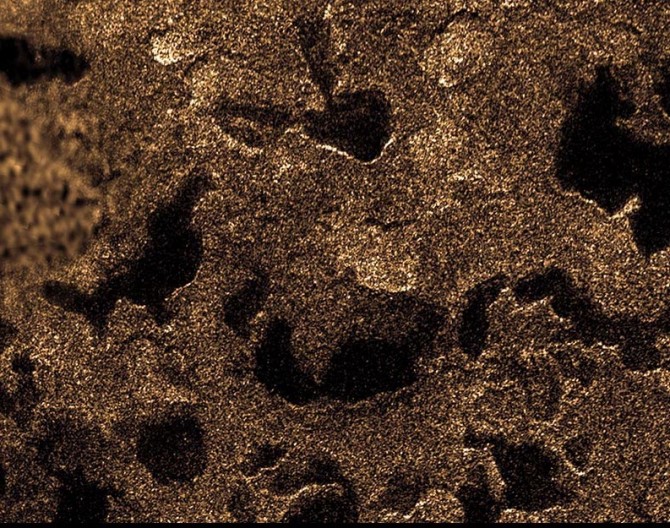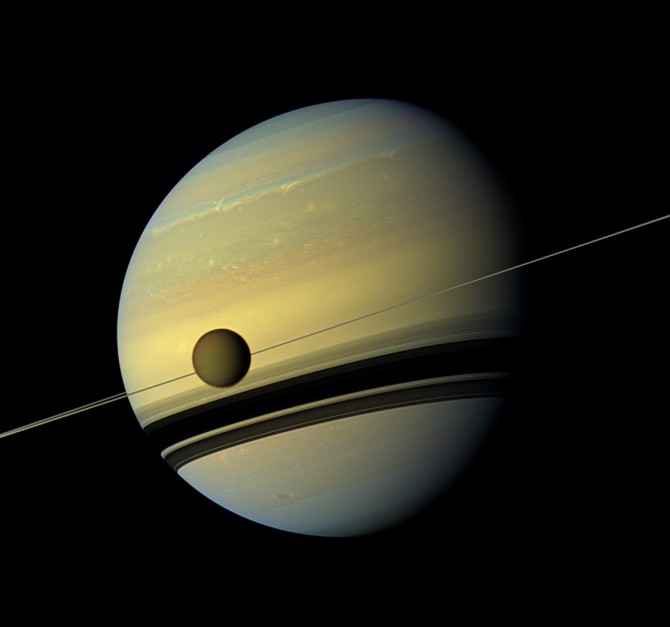Cassini’s last Titan flyby reveals deep methane lakes, Earth-like cycles
By Blaine Friedlander
By examining data from the Cassini spacecraft’s last close encounter with Saturn’s moon Titan, scientists have found that its methane-filled lakes are up to 300 feet deep, much deeper than previously thought.
The lakes also seem to feed underground reservoirs that pour into Titan’s seas – offering evidence of a hydrologic-like cycle on another place in the solar system, according to Cornell, Caltech and international researchers publishing in Nature Astronomy, April 15.
“Cassini’s 13-year mission studied the entire neighborhood of Saturn, and this last Titan flyby [April 22, 2017] was the first chance to make depth and composition measurements on the smaller lakes in Titan’s northern hemisphere,” said co-author Jonathan Lunine, the David C. Duncan Professor in the Physical Sciences and director of Cornell’s Center for Astrophysics and Planetary Science.
“The northern lakes turn out to be very deep and steep-walled – or ‘steep and deep’ – suggesting that the lakes may form by chemically dissolving away their surroundings,” said Lunine. “Comparing the water lakes here on Earth, the geologic term would be ‘karstic.’”
Marco Mastrogiuseppe, a former Cornell postdoctoral researcher who’s now a postdoc at Caltech, led the work.
Titan is an exotic place. Think of it as an Earth-like, geologic wonderland made of hydrocarbon but with less gravity. It’s a world where methane raindrops the size of marbles fall slowly to a ground surface covered in organics. The rain fills the lakes. While the deep lakes are perched far above the orange landscape, the liquid methane seems to flow underground to fill Titan’s seas – which are as flat as paper. The 5-millimeter-high sea waves crest to a gnarly 1 centimeter.
Valerio Poggiali, a postdoctoral research and a co-author, said that Titan’s isolated northern lakes do not have rivers flowing in and out; instead the lakes are filled with liquid methane rain.
“The lakes are stable on Titan. For long periods of time, these lakes are filled,” he said. “While Titan should have a river-like phenomena, the methane travels from the lakes to the seas by subsurface. All the lakes we studied have the same composition. They are connected.”
Earth and Titan are the only bodies in the solar system where liquids are stable on the planet or moon’s surface. Said Lunine: “The big picture is reinforcing the idea of an Earth-like nature to Titan, in terms of landforms, but it has an exotic nature in terms of the working materials of the geologic processes.”
In addition to Mastrogiuseppe, Lunine and Poggiali, the co-authors were: Alex Hayes, Cornell associate professor of astronomy; Roberto Seu, University of Rome, Italy; Giuseppe Mitri, International Research School of Planetary Studies, D’Annunzio University, Italy; and Ralph Lorenz, Johns Hopkins University Applied Physics Lab. Funding for this research was provided by NASA.
In a related paper concurrently published in Nature Astronomy, researchers used Cassini radar and spectral data to identify features in Titan’s northern lakes. The features appeared as liquid hydrocarbon bodies during the moon’s winter but became visible as land in the spring. That study was led by Shannon MacKenzie of the Johns Hopkins University Applied Physics Lab, and included co-authors Sam Birch, Ph.D. ’19; Jason D. Hofgartner, M.S. ’14, Ph.D. ’16; and Matthew M. Hedman, former Cornell researcher now an assistant professor at the University of Idaho.
Lunine, Hayes, Poggiali and Birch are fellows at Cornell’s Carl Sagan Institute.
Media Contact
Get Cornell news delivered right to your inbox.
Subscribe
